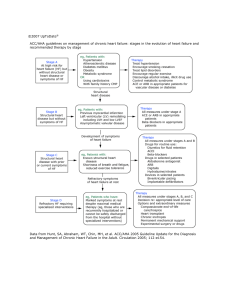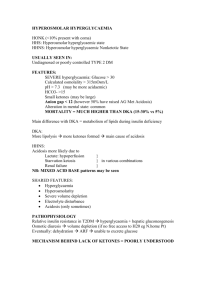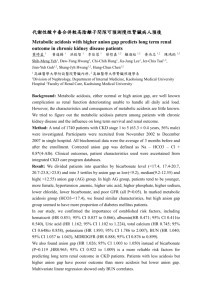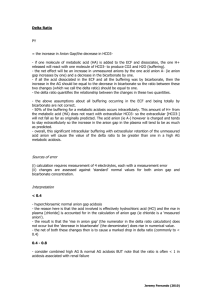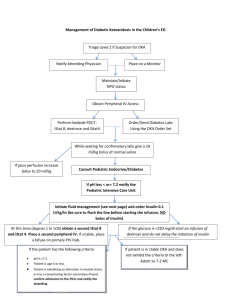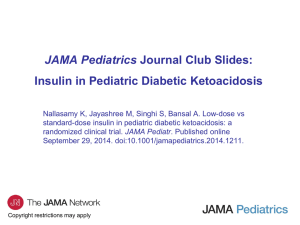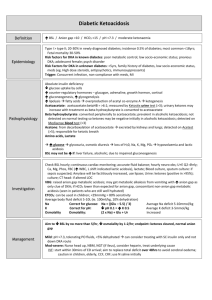Ketoacidosis
advertisement
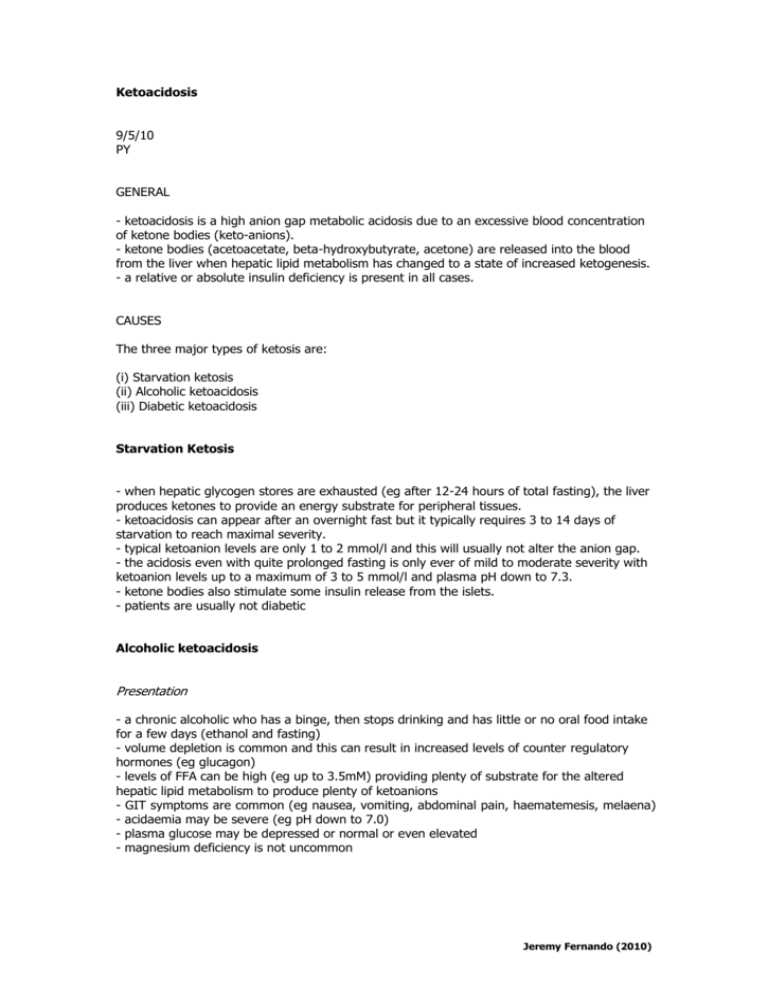
Ketoacidosis 9/5/10 PY GENERAL - ketoacidosis is a high anion gap metabolic acidosis due to an excessive blood concentration of ketone bodies (keto-anions). - ketone bodies (acetoacetate, beta-hydroxybutyrate, acetone) are released into the blood from the liver when hepatic lipid metabolism has changed to a state of increased ketogenesis. - a relative or absolute insulin deficiency is present in all cases. CAUSES The three major types of ketosis are: (i) Starvation ketosis (ii) Alcoholic ketoacidosis (iii) Diabetic ketoacidosis Starvation Ketosis - when hepatic glycogen stores are exhausted (eg after 12-24 hours of total fasting), the liver produces ketones to provide an energy substrate for peripheral tissues. - ketoacidosis can appear after an overnight fast but it typically requires 3 to 14 days of starvation to reach maximal severity. - typical ketoanion levels are only 1 to 2 mmol/l and this will usually not alter the anion gap. - the acidosis even with quite prolonged fasting is only ever of mild to moderate severity with ketoanion levels up to a maximum of 3 to 5 mmol/l and plasma pH down to 7.3. - ketone bodies also stimulate some insulin release from the islets. - patients are usually not diabetic Alcoholic ketoacidosis Presentation - a chronic alcoholic who has a binge, then stops drinking and has little or no oral food intake for a few days (ethanol and fasting) - volume depletion is common and this can result in increased levels of counter regulatory hormones (eg glucagon) - levels of FFA can be high (eg up to 3.5mM) providing plenty of substrate for the altered hepatic lipid metabolism to produce plenty of ketoanions - GIT symptoms are common (eg nausea, vomiting, abdominal pain, haematemesis, melaena) - acidaemia may be severe (eg pH down to 7.0) - plasma glucose may be depressed or normal or even elevated - magnesium deficiency is not uncommon Jeremy Fernando (2010) Pathophysiology - the poor oral intake results in decreased glycogen stores, a decrease in insulin levels and an increase in glucagon levels - hepatic metabolism of ethanol to acetaldehyde and then to acetate both involve NAD+ as a cofactor -> the NADH/NAD+ ratio rises and this: (i) inhibits gluconeogenesis (ii) favours the production of beta-hydroxybutyrate over acetoacetate - insulin deficiency results in increased mobilisation of free fatty acids from adipose tissue -> the decreased insulin/glucagon ratio results in a switch in hepatic metabolism favouring increased beta-oxidation of fatty acids -> increased production of acetylCoA which forms acetoacetate (a keto-acid). Management - this syndrome is rapidly reversed by administration of glucose and insulin. - a mixed acid-base disorder may be present: high anion gap due to ketoacidosis, metabolic alkalosis due to vomiting and a respiratory alkalosis. Diabetic ketoacidosis Presentation - involves an absolute or relative lack of insulin leads to diabetic metabolic decompensation with hyperglycaemia and ketoacidosis. - a precipitating factor (eg infection, stress) which causes an excess of stress hormones (which antagonise the actions of insulin) may be present. - the most common situations in patients presenting with DKA are: (i) infection as precipitant (30% of cases) (ii) treatment non-compliance (20%) (iii) new diagnosis of diabetes (25%) (iv) no known precipitating event (25%) Pathophysiology - the pathogenesis requires two events: (i) increased mobilisation of FFA and (ii) a switch of hepatic lipid metabolism to ketogenesis (i) increased mobilisation of free fatty acids (FFA) from adipose tissue to the liver - FFA mobilisation is initiated by the effect of absolute or relative insulin deficiency on fat cells. - FFA levels can be quite high (eg 2.5 to 3.5 mM) -> this provides the liver with plenty of substrate - FFA levels are much less then ketone levels and contribute only a small amount to the metabolic acidosis. (ii) a switch of hepatic lipid metabolism to ketogenesis Jeremy Fernando (2010) - the major switch in hepatic lipid metabolism occurs in response not just to insulin deficiency but additionally to the concomitant rise in levels of the stress hormones (glucagon, corticosteroids, catecholamines, growth hormone). - the hepatic effects of a fall in the insulin:glucagon ratio are increased glycogenolysis, increased gluconeogenesis, increased ketogenesis - the inhibition of the enzyme acetyl CoA carboxylase is probably the key step -> this enzyme is inhibited by increased FFA levels, decreased insulin levels and particularly by the rise in glucagon. - the problem however is not just of hepatic over-production of glucose and ketones but also of peripheral underutilisation of both glucose and ketones. Development of high anion gap acidosis in DKA - acetoacetic acid (pKa 3.58) and beta-hydroxybutyric acid (pKa 4.70) dissociate producing H+ which is buffered by HCO3- in the blood - for each anion produced there is a loss of one bicarbonate - the increase in the anion gap (representing the increase in the unmeasured acid anions) should approximately equal the decrease in the [HCO3-]. - a 'pure' high anion gap metabolic acidosis results. Development of hyperchloraemic acidosis - in some cases, a hyperchloraemic metabolic acidosis develops: this is most common during the treatment phase. - this occurs because acetoacetate and beta-hydroxybutyrate are moderately strong acids and even at the lowest urinary pH are significantly ionised. - they are excreted with a cation (usually Na+ or K+) to maintain electroneutrality -> net effect is the loss of 'potential bicarbonate' equal to the level of urinary ketone body loss. Mixed acidosis - at presentation, both types of acidosis may be present and the elevation in the anion gap will be less than expected for the degree of depression in the bicarbonate level (resulting in delta ratio < 0.8). - a predominant hyperchloraemic acidosis (defined as a DKA patient with a delta ratio < 0.4) is present in about 10% of patients on arrival at hospital and in about 70% after 8 hours of treatment. - patients who are more severely dehydrated retain more keto-anions and have a lower incidence of hyperchloraemic acidosis. - patients who have been able to maintain fluid intake during development of their illness are more likely to have a hyperchloraemic acidosis component present on admission - administration of large volumes of normal saline in resuscitation of patients with acute DKA promotes continued diuresis (and continued loss of ketone bodies with Na+ as the cation) and provides plenty of chloride to replace the lost ketoanions. Other acid base disorders in DKA (i) Lactic acidosis due to hypoperfusion and anaerobic muscle metabolism (ii) Metabolic alkalosis secondary to excessive vomiting (iii) Respiratory acidosis due to pneumonia or mental obtundation (iv) Respiratory alkalosis with sepsis (v) Renal tubular acidosis (type 4) is present in some diabetic patients and the associated urinary acidification defect can cause a hyperchloraemic normal anion gap acidosis -> known Jeremy Fernando (2010) as hyporeninemic hypoaldosteronism -> occurs in elderly diabetic patients who have preexisting moderate renal insufficiency but is not a common problem in acute DKA Jeremy Fernando (2010)

